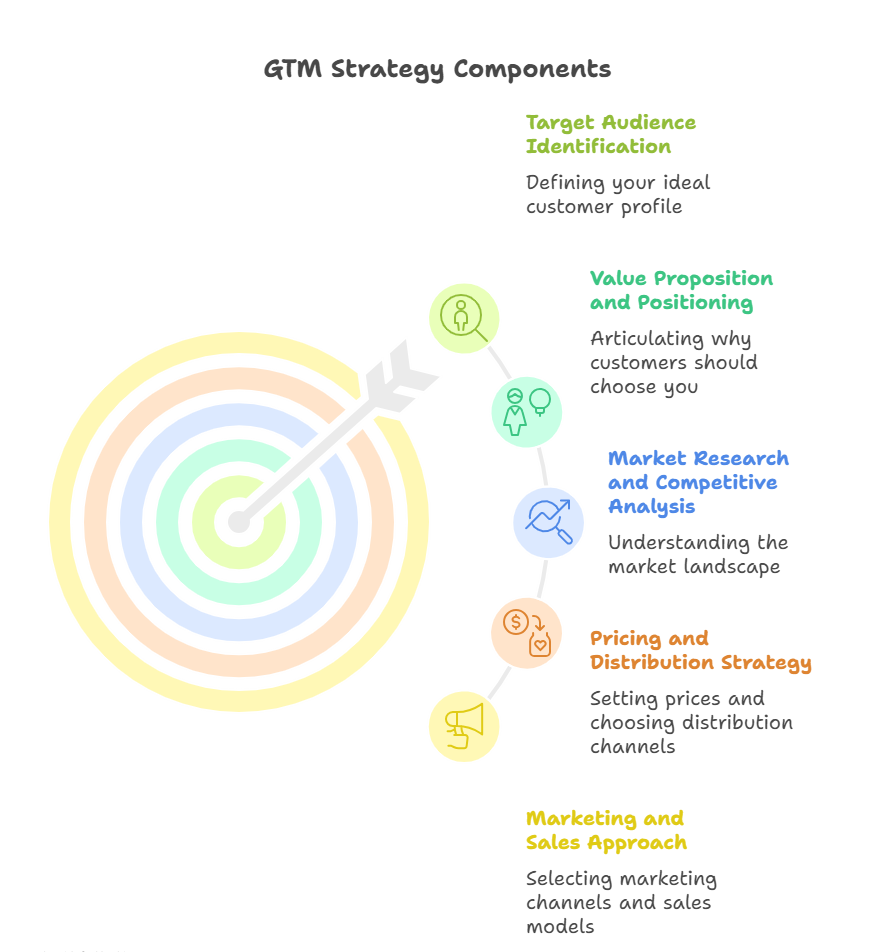How to Build a Go-to-Market Strategy: A Step-by-Step Guide
Learn how to build an effective go-to-market strategy with our comprehensive framework. Identify target audiences, define value propositions, and launch successfully.
What Is a Go-to-Market Strategy?
A go-to-market (GTM) strategy is a step-by-step plan for launching a new product or expanding into a new market. According to Harvard Business School, it's how your venture will reach customers and turn prospects into buyers. This strategic framework ensures you're not just building a great product, but also effectively delivering it to the right audience at the right time.
Think of your GTM strategy as the bridge between product development and market success. It answers critical questions about who your customers are, what problem you solve for them, and how you'll communicate your value proposition effectively.
The Core Components of a GTM Strategy

Target Audience Identification
Your first step is defining exactly who you're selling to. This involves creating detailed buyer personas and identifying your ideal customer profile (ICP). Many marketers struggle with this step, as noted in a Reddit discussion where professionals highlighted the challenge of building ICPs when dealing with multiple products and diverse customer demands.
Key questions to answer:
- Who experiences the problem your product solves?
- What are their demographics, behaviors, and pain points?
- How do they make purchasing decisions?
Value Proposition and Positioning
Your value proposition clearly articulates why customers should choose your solution over alternatives. This isn't just about features—it's about the specific benefits and outcomes your customers will achieve. Asana emphasizes that defining your value proposition is essential for successful product launches.
Market Research and Competitive Analysis
Before launching, conduct thorough market research to understand your competitive landscape, market size, and customer needs. Harvard Business School Senior Lecturer Jeffrey Bussgang advises conducting experiments and market research before diving into GTM strategy to ensure your product actually fulfills customer needs.
Pricing and Distribution Strategy
Your pricing model should reflect the value you deliver while remaining competitive. Equally important is selecting the right distribution channels—whether direct sales, online platforms, retail partnerships, or other avenues that match how your target customers prefer to buy.
Marketing and Sales Approach
Choose marketing channels that align with where your audience spends time and how they discover solutions. Common GTM approaches include:
- Product-led growth (self-service model)
- Sales-led growth (direct sales team)
- Channel partnerships (through resellers or affiliates)
- Content marketing and SEO
Building Your GTM Strategy: A Step-by-Step Framework
Step 1: Define Your Target Market
Start by segmenting your potential market and selecting the most promising segments to target first. Consider factors like:
- Market size and growth potential
- Customer accessibility
- Competitive intensity
- Alignment with your capabilities
Step 2: Develop Your Messaging
Craft compelling messaging that resonates with each customer segment. Your messaging should:
- Clearly state the problem you solve
- Explain your unique solution
- Highlight key benefits and differentiators
- Include proof points and social validation
Step 3: Choose Your Channels
Select marketing and sales channels based on where your target customers are most receptive. As Reddit users noted, there are many GTM strategies including SEO, paid ads, cold outreach, and partnerships—the key is choosing what works for your specific audience and product.
Step 4: Set KPIs and Metrics
Establish clear key performance indicators (KPIs) to measure your GTM success. Common metrics include:
- Customer acquisition cost (CAC)
- Conversion rates at each funnel stage
- Customer lifetime value (LTV)
- Time to first value
- Market share growth
Step 5: Plan Your Launch Timeline
Create a detailed timeline that coordinates all aspects of your launch—from product development and marketing campaigns to sales enablement and customer support readiness.
Common GTM Strategy Mistakes to Avoid
Many teams stumble by skipping crucial steps in their GTM planning. Common pitfalls include:
- Launching without validated product-market fit
- Targeting too broad an audience instead of focusing on early adopters
- Underestimating the importance of timing in scaling sales and marketing teams
- Failing to align cross-functional teams around the GTM plan
Harvard Business School emphasizes that determining when to scale your sales and marketing teams is a vital part of your GTM strategy that requires careful planning.
Visualizing Your GTM Strategy with Mind Maps
Building a comprehensive GTM strategy involves connecting multiple moving parts—from customer insights to channel selection to performance metrics. Using a mind map can help you visualize these connections and ensure nothing falls through the cracks.
At ClipMind, we've found that visual frameworks make complex strategies more accessible and actionable. Our AI SWOT Analyzer and STP Analyzer can help you systematically evaluate your market position and segmentation as part of your GTM planning process.
Putting It All Together
A well-crafted go-to-market strategy is your roadmap to successful product adoption and revenue growth. By systematically addressing each component—from target audience definition to channel selection and performance measurement—you increase your chances of launching successfully and scaling efficiently.
Remember that your GTM strategy should evolve as you gather customer feedback and market data. What works during initial launch may need adjustment as you expand to new segments or markets, making ongoing strategy refinement an essential practice for long-term success.
 ClipMind
ClipMind